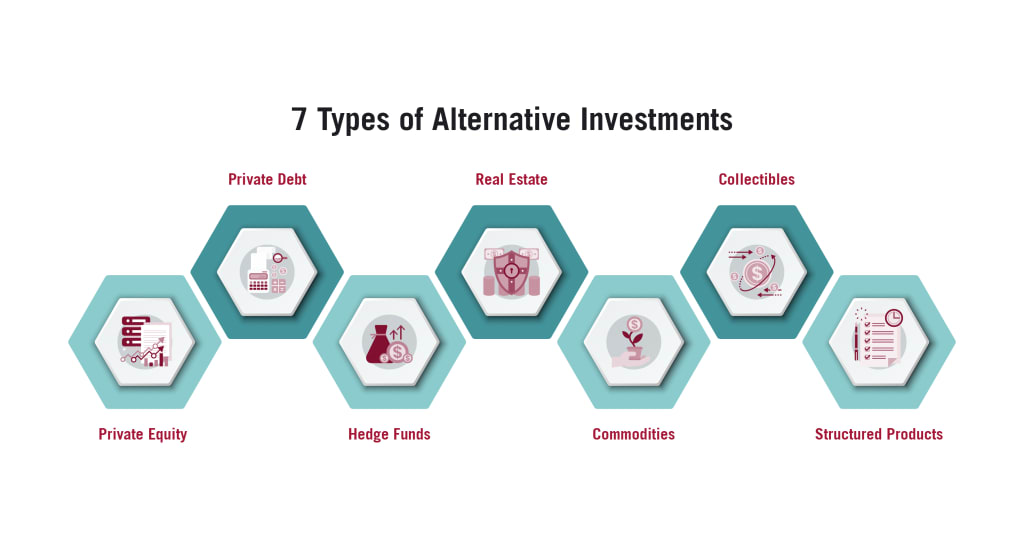Alternative Investments: Exploring Beyond Stocks and Bonds
Alternative Investments

Introduction
When it comes to investing, many people think primarily of stocks and bonds. However, alternative investments have gained popularity as investors seek to diversify their portfolios and explore different avenues for potential returns. Alternative investments encompass a wide range of assets that offer unique characteristics and potential benefits. In this article, we will delve into the world of alternative investments, explore various options available, and discuss the considerations for integrating alternative investments into an investment portfolio.
1. Understanding Alternative Investments
a. Definition and Characteristics: Alternative investments refer to assets outside the traditional realm of stocks, bonds, and cash. They typically have low correlation with traditional assets, meaning their performance may not align with the stock market or interest rate movements.
b. Diverse Asset Classes: Alternative investments encompass a diverse range of asset classes, including real estate, commodities, private equity, venture capital, hedge funds, infrastructure, art, wine, and more. Each asset class offers unique risk-return profiles and investment opportunities.
c. Illiquidity and Complexity: Alternative investments often come with longer lock-up periods, limited liquidity, and complex structures. Investors should be prepared to commit funds for a more extended period and understand the specific terms and conditions associated with each investment.
2. Benefits of Alternative Investments
a. Diversification: Alternative investments provide an opportunity to diversify a portfolio beyond traditional asset classes. Their low correlation with stocks and bonds can help reduce overall portfolio risk and potentially enhance risk-adjusted returns.
b. Potential for Higher Returns: Some alternative investments have historically delivered higher returns than traditional assets. Investments in private equity, venture capital, or certain real estate ventures, for example, can offer the potential for attractive long-term returns.
c. Inflation Hedge: Certain alternative investments, such as real estate, commodities, and infrastructure, have the potential to act as an inflation hedge. These assets may benefit from rising prices and provide a safeguard against the eroding effects of inflation.
d. Access to Unique Opportunities: Alternative investments provide access to unique investment opportunities that are not easily available in the public markets. This can include investments in early-stage companies, private real estate projects, or specialized funds that focus on specific sectors or strategies.
3. Considerations for Integrating Alternative Investments
a. Risk and Due Diligence: Alternative investments can involve higher risk compared to traditional assets. Thorough due diligence is essential, including evaluating the investment's underlying fundamentals, management team, track record, and risk management practices.
b. Investment Horizon and Liquidity: Consider your investment horizon and liquidity needs before allocating funds to alternative investments. Many alternative investments have longer lock-up periods, making them illiquid during the investment term.
c. Professional Guidance: Given the complexity and unique characteristics of alternative investments, seeking advice from professionals such as financial advisors or investment consultants can help navigate the landscape effectively. They can provide insights, conduct due diligence, and recommend suitable options based on your investment goals and risk tolerance.
d. Portfolio Allocation and Diversification: Determine the appropriate allocation to alternative investments based on your risk profile and overall investment strategy. Consider the desired level of diversification, as well as the impact of alternative investments on your portfolio's risk and return characteristics.
e. Regulatory and Tax Considerations: Alternative investments may be subject to specific regulations and tax implications. Understand the legal and tax aspects associated with each investment to ensure compliance and optimize after-tax returns.
4. Examples of Alternative Investments
a. Real Estate: Investing in commercial properties, residential properties, real estate investment trusts (REITs), or real estate crowdfunding platforms.
b. Private Equity and Venture Capital: Investing in privately held companies or funds that invest in early-stage or growth-stage businesses.
c. Hedge Funds: Investing in professionally managed funds that employ various strategies to potentially generate positive returns in different market conditions.
d. Commodities: Investing in physical commodities such as gold, silver, oil, or agricultural products to benefit from price movements or as a hedge against inflation.
e. Infrastructure: Investing in infrastructure projects, such as airports, toll roads, renewable energy projects, or public utilities.
f. Art and Collectibles: Investing in art, rare coins, fine wine, or other collectibles that have the potential for appreciation over time.
5. Risk Management and Due Diligence
a. Thorough Research: Conduct thorough research and due diligence on the specific alternative investment before committing funds. Analyze the investment's historical performance, underlying assets or businesses, management team, fees, and potential risks.
b. Risk Mitigation Strategies: Implement risk mitigation strategies such as diversifying investments across different alternative asset classes, conducting ongoing monitoring, and setting realistic return expectations.
c. Professional Partnerships: Consider partnering with professionals who specialize in alternative investments, such as fund managers, advisors, or consultants. Their expertise can help navigate the complexities and mitigate potential risks associated with these investments.
Conclusion
Alternative investments offer investors the opportunity to diversify their portfolios, potentially enhance returns, and access unique investment opportunities beyond traditional asset classes. By understanding the characteristics, benefits, and considerations associated with alternative investments, investors can make informed decisions and effectively integrate them into their investment strategies. However, it is important to note that alternative investments come with their own set of risks and complexities, requiring thorough research, due diligence, and professional guidance. As with any investment, careful consideration of risk, liquidity, and alignment with your overall financial goals and risk tolerance is essential. By incorporating alternative investments into a well-diversified portfolio, investors can potentially enhance their risk-adjusted returns and achieve greater investment resilience in a dynamic market environment.
About the Creator
Enjoyed the story? Support the Creator.
Subscribe for free to receive all their stories in your feed. You could also pledge your support or give them a one-off tip, letting them know you appreciate their work.





Comments
There are no comments for this story
Be the first to respond and start the conversation.